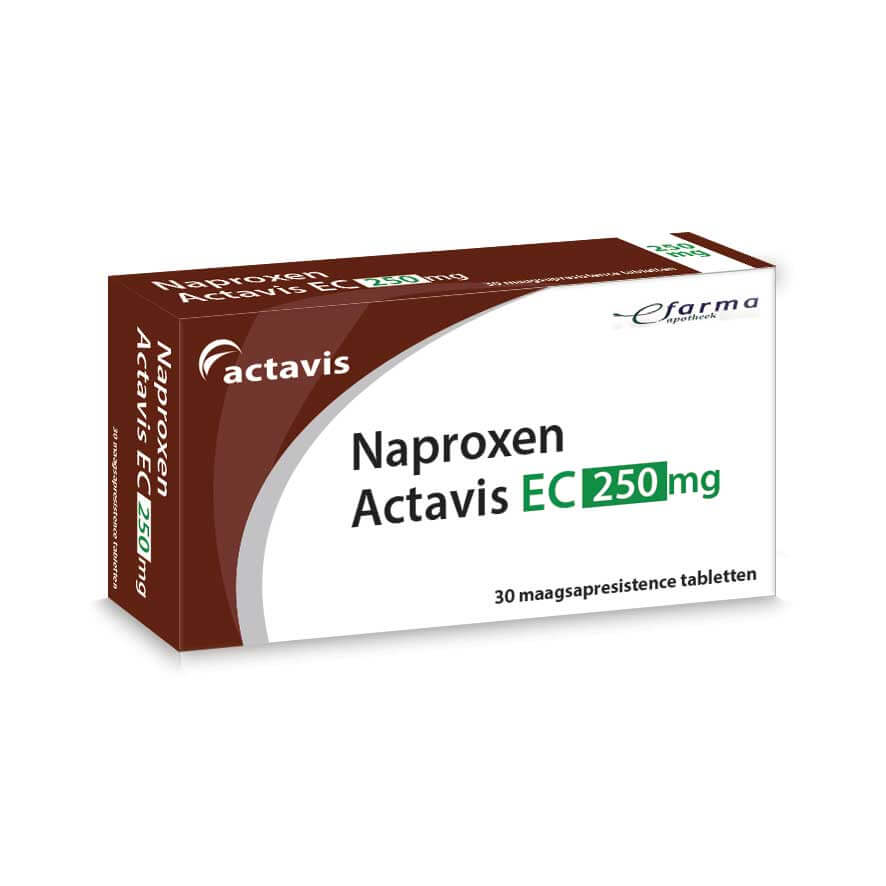*Brands may vary. please contact us for specific brands.
Naproxen Enteric Coated (56 Tablets)
£21.99 – £30.49
- Used To Relieve Pain In Joints And Muscles
- Non-Steroidal Anti-Inflammatory
- Active Ingredient: Naproxen
- Buy With Confidence From UK Registered Pharmacy
- Includes Free Prescription
Naproxen 250mg & 500mg is a ‘Non Steroidal Anti Inflammatory Drug’ or NSAID. Naproxen Tablets can relieve pain, swelling, redness and heat (inflammation). Inflamed and painful joints and muscles can be debilitating to live with, making it difficult to move around in your daily tasks.
See our naproxen non coated options.
| Options | Price | Stock |
|---|---|---|
| 250mg | £21.99 | In Stock |
| 375mg | £24.49 | In Stock |
| 500mg | £30.49 | In Stock |

Discreet Packaging

UK Based
-
- Overview: What Makes My Pharmacy Your Ideal Choice?
- Next-Day Delivery: Getting Your Treatment Swiftly
- How to Properly Take Naproxen
- Types and Uses of Coated Naproxen Tablets
- Frequently Asked Questions about Naproxen
- Precautions: Side Effects and Other Concerns
- Alternatives to Naproxen Enteric Coated
- Conclusion: Why Choose My Pharmacy?
Overview: What Makes My Pharmacy Your Ideal Choice?
Welcome to My Pharmacy, the UK’s premier independent online pharmacy. If you're looking to buy Naproxen Enteric Coated 500 mg tablets, you're in the right place. To purchase this medication online in the UK, it is essential to have a valid prescription. Don't worry if you don't have one yet; our free online consultation service can help you get the prescription you need, seamlessly and hassle-free.Next-Day Delivery: Getting Your Treatment Swiftly
We understand that when you're in pain, time is of the essence. That's why My Pharmacy offers Next-Day Delivery on Naproxen Enteric Coated 500 mg Online in the UK. Rest assured, your medication will arrive in discreet and secure packaging, ensuring complete privacy and integrity of the product. Explore our range of pain relief products to find more options suitable for your needs.How to Properly Take Naproxen
It's crucial to follow your doctor's instructions on how to take Naproxen GR tablets. Typically, they should be swallowed whole with water, either with or after food to minimize the risk of gastrointestinal issues. Common Dosages:- Rheumatoid Arthritis: 500mg to 1g per day in two separate doses
- Gout: Initial dose of 750mg, followed by 250mg every 8 hours
- Muscle Disorders & Menstrual Pain: 500mg as a single dose
Types and Uses of Coated Naproxen Tablets
If you've experienced gastrointestinal side effects with non-coated Naproxen tablets, Enteric Coated Naproxen is a viable option. These tablets are designed to release the medicine in the intestine, reducing irritation to the stomach lining. Available Strengths:- Naproxen EC 500 mg: Effective for severe pain conditions like rheumatoid arthritis, tendinitis, and period pain.
- Naproxen EC 375 mg: Used for moderate pain relief in conditions such as muscle issues, joint problems, and gout.
- Naproxen EC 250 mg: Useful for milder symptoms and works by limiting the substances in your body that cause inflammation.
Frequently Asked Questions about Naproxen
Q: What is Naproxen EC 500 mg? A: Naproxen belongs to a class of medicines called NSAIDs (Non-Steroidal Anti-Inflammatory Drugs). They are primarily used to reduce inflammation and treat conditions like:- Rheumatoid arthritis
- Osteoarthritis
- Ankylosing spondylitis
Precautions: Side Effects and Other Concerns
Possible Side Effects Not everyone experiences side effects, but if you do, consult your doctor. Common symptoms include:- Confusion or headache
- Vision changes
- Fatigue
- Dizziness
- Rashes
- Pregnancy: It’s advised not to take Apo Naproxen EC during pregnancy unless the benefits outweigh the risks.
- Breastfeeding: Use with caution; other anti-inflammatory medicines are generally considered safer.
- Diarrhoea: Can be a serious side effect, especially if accompanied by indigestion symptoms.
Alternatives to Naproxen Enteric Coated
If Naproxen Enteric Coated isn't suitable for you, My Pharmacy offers various alternatives:- Uncoated Naproxen Tablets: For those who can tolerate NSAIDs without the gastrointestinal side effects, uncoated Naproxen tablets are available. These tablets offer the same anti-inflammatory and pain-relieving benefits as their enteric coated counterparts but without the protective coating.
- Mefenamic Acid 500mg Tablets: Another anti-inflammatory and pain relief medication, Mefenamic Acid can be a suitable alternative to Naproxen. It is often prescribed for menstrual pain but can also treat a variety of other conditions such as arthritis and mild to moderate pain.
- Mefenamic Acid 250mg Capsules: For those who prefer capsules over tablets, or who require a lower dosage, Mefenamic Acid is also available in 250mg capsules. These offer the same range of benefits as the 500mg tablets but are designed for easier swallowing or for those who require a lower dose.
Conclusion: Why Choose My Pharmacy?
My Pharmacy offers a seamless, efficient, and private way to obtain prescription medications like Naproxen Enteric Coated online. With next-day delivery options and a free online consultation service, we make the process of acquiring the medication you need as simple as possible. Thank you for choosing My Pharmacy, your trusted UK online pharmacy. -
Pain Relief
Types of arthritis
Arthritis is a common condition that causes pain and inflammation in a joint. In the UK, around 10 million people have arthritis. It affects people of all ages, including children.
The two most common types of arthritis are:
Osteoarthritis
Rheumatoid arthritisOsteoarthritis
Osteoarthritis is the most common type of arthritis in the UK, affecting around 8 million people.
It most often develops in adults who are in their late 40s or older.Osteoarthritis initially affects the smooth cartilage lining of the joint. This makes movement more difficult than usual, leading to pain and stiffness.
The most commonly affected joints are those in the Hands,Spine,Knees andHips
Rheumatoid arthritis
In the UK, rheumatoid arthritis affects more than 400,000 people. It often starts when a person is between 40 and 50 years old. Women are three times more likely to be affected than men.
Rheumatoid and osteoarthritis are two different conditions. Rheumatoid arthritis occurs when the body’s immune system targets affected joints, which leads to pain and swelling.
The outer covering (synovium) of the joint is the first place affected. This can then spread across the joint, leading to further swelling and a change in the joint’s shape. This may cause the bone and cartilage to break down.
Other types of arthritis and related conditions
Ankylosing spondylitis – a long-term inflammatory condition that mainly affects the bones, muscles and ligaments of the spine, leading to stiffness and joints fusing together.Fibromyalgia – causes pain in the body’s muscles, ligaments and tendons.
Gout – a type of arthritis caused by too much uric acid in the body. This can be left in joints (usually affecting the big toe) but can develop in any joint. It causes intense pain, redness and swelling.
Psoriatic arthritis – an inflammatory joint condition that can affect people with psoriasis.Enteropathic arthritis – a form of chronic, inflammatory arthritis associated with inflammatory bowel disease (IBD), the two best-known types being ulcerative colitis and Crohn’s disease.
Secondary arthritis – a type of arthritis that can develop after a joint injury and sometimes occurs many years afterwards.
Polymyalgia rheumatica – a condition that almost always affects people over 50 years of age, where the immune system causes muscle pain and stiffness, usually across the shoulders and tops of the legs. It can also cause joint inflammation.
Period pain
Period pain is common and a normal part of your menstrual cycle. Most women experience it at some point in their lives.It’s usually felt as painful muscle cramps in the tummy, which can spread to the back and thighs.
The pain sometimes comes in intense spasms, while at other times it may be dull but more constant.
What causes period pain?
Period pain occurs when the muscular wall of the womb tightens (contracts).
During your period, the wall of the womb starts to contract more vigorously to encourage the womb lining to shed away as part of your monthly period.When the muscular wall of the womb contracts, it compresses the blood vessels lining your womb. This temporarily cuts off the blood supply – and hence oxygen supply – to your womb. Without oxygen, the tissues in your womb release chemicals that trigger pain.
While your body is releasing these pain-triggering chemicals, it’s also producing other chemicals called prostaglandins. These encourage the womb muscles to contract more, further increasing the level of pain.
Period pain caused by a condition
Less commonly, period pain can be caused by an underlying medical condition. Doctors sometimes call this secondary dysmenorrhoea.Period pain linked to an underlying condition tends to affect older women. Women aged 30 to 45 are most commonly affected.
Conditions that can cause period pain include:
endometriosis – where cells that normally line the womb start to grow in other places, such as in the fallopian tubes and ovaries; these cells can cause intense pain when they shed and fall away
fibroids – non-cancerous tumours that can grow in the womb and can make your periods heavy and painful
pelvic inflammatory disease – where your womb, fallopian tubes and ovaries become infected with bacteria, causing them to become severely inflamed
adenomyosis – where the tissue that normally lines the womb starts to grow within the muscular womb wall, making your periods particularly painful -
Further Information
Side Effect
More common side effects
The more common side effects that occur with naproxen oral tablet include:
Stomach pain
Constipation
Diarrhea
Gas
Heartburn
Nausea and vomiting
Dizziness
Mild side effects may go away within a few days or a couple of weeks. Talk to your doctor or pharmacist if they’re more severe or don’t go away.Serious side effects
Call your doctor right away if you have serious side effects. Call 911 if your symptoms feel life-threatening or if you think you’re having a medical emergency. Serious side effects and their symptoms can include the following:
Chest pain
Shortness of breath or trouble breathing
Weakness in one part or side of your body
Difficulty speaking
Swelling of the face or throat
High blood pressure
Bleeding and ulcers in your stomach and intestines, with symptoms such as:
Stomach pain
Bloody vomit
Blood in your stool
Black and sticky stool
Asthma attacks in people who have asthma
Low red blood cell count, which can cause fatigue, lethargy, and weakness
Yellowing of your skin or the whites of your eyes
Unusual weight gain or swelling of your arms, legs, hands, and feet
Skin rash or blisters with fever













